Succulent plants are those which have thick, fleshy leaves and stems. Another prominent characteristic is their enlarged root system. These plants can hold a greater volume of water for longer periods within their bulky framework.
As a result, succulents don’t require as frequent a watering schedule as other plants. They can go whole seasons without water once they adapt to their environment. They suck in all of the moisture they can when the chance arrives. They then use this supply sparingly if it’s a while between drinks.
But exactly how long can succulents go without water? Well, that’s the answer we will be seeking here in this article.

Succulents are truly amazing species of plants! They tend to get soft, wrinkly, or puckered when it’s time to top up their water supply. Another way to tell that they are thirsty is when the soil they grow in becomes bone dry. It sounds somewhat harsh, but that’s how these plants thrive.
Table of Contents
How long can Succulents Go Without Water?
Some succulent species can thrive well without receiving any water for 2 weeks; other types, such as the Crassula and Graptopetalum, can last upto 3 months. Some desert cacti variants, such as Saguaro and Prickly Pear, can go for 2 years without water.
It all depends on multiple determining factors, which we can look at here…

Age and Type of succulent
Younger succulents are grown from a plant’s offsets or as cuttings generally require more water than a mature succulent plant. It’s recommended that the younger plants are watered every day or two to make sure that they can establish themselves in their new environment.
Typically speaking, the species of succulents that can go for longer periods without water have a couple of distinguishable characteristics. These include thicker stems and branches and more plump leaves, and robust root systems. The more prominent these features are, the less watering is required.
Some examples of these variants include Graptopetalum Paraguayans, a few types of Echeveria such as the Albicans or Elegans, and specific Crassula hybrids.
Outdoors hot climate or indoors Climate
The soil of succulent plants tends to dry out faster when outdoors. They have the wind, the sun, and possibly even faster-draining soil to compete with. These factors can affect the watering schedule frequency.
The best indicator for watering an outdoor succulent is checking the soil moisture content. If the plant has a dry soil area around the base, it will need some water.
In general, these plants require a top-up of water from between 1-3 weeks in the warmer months of the year. Cooler months can last longer without water, some from between 1-3 months. The soil can stay moist for a lot longer with the drop in temperature.
On the other hand, indoor succulents are generally the same time frame as outdoor in the cooler months, and they are less exposed to the conditions that the outdoor variants are. So around 1-3 months between drinks is adequate for indoor succulents.
One thing to be careful of with indoor succulents is overwatering, and too much water can cause root rot. Make sure that you confirm that the plant’s soil is bone dry before adding any extra water to the pot. Other signs that your plant may require watering are wrinkled leaves and flat leaves that have lost their soft plumpness.
Season of the year
Different seasons will affect the amount of watering that a succulent requires. Again it will depend on the type. They go dormant during the winter months and don’t require as much water to survive. In general, though, outdoor planted succulents can last much longer without water in the winter than in the summer.
The soil stays moist, and it can be given some extra water from the rain if in an area with those weather patterns. It’s not safe to stop watering them altogether but easing up and watering them once per month is ample for this year.
Always check the soil around the plant as an indicator, though. It’s not a good idea to just rely on a time of year as a guide. Conditions can change.
Location
A plant’s geographical location can also factor when planning a watering schedule for succulents. The hotter, more arid, or dry areas of the world have a host of succulent species that can and do thrive for quite some time on minimal water.
This is because they have established themselves there and have learned to adapt to their surroundings. They generally have larger, more plump stems and leaves which hold more water for longer. Succulents grown in these conditions require much less water than in cooler locations.
Pot material, color, and size
The materials used to grow a succulent can single-handedly kill or assist your plant is thriving. Materials with better drainage, such as gravel, peat mix, and even shell grit mixes, are ideal. These will reduce the risk of root rot and keep the water received much cleaner due to the drainage qualities these materials possess.
The size of the pot is equally important. Larger pots will ensure that the succulent retains that extra bit more moisture content compared to smaller pots. Pot color is another factor that can affect watering. Darker pots attract heat, and the water will evaporate faster, requiring more frequent watering.
Terracotta and clay are great alternatives due to their porous nature, and they can retain moisture for longer without pooling. In general, succulents grown in the ground can last longer than those grown in pots.
They can establish their root system much better and stronger on the ground, and they also have better access to moisture from the soil in the ground.
Soil Condition
As we just touched on, the soil condition can greatly affect the required amount of water that a succulent may require. If the soil has good drainage, filtration, and compaction around the roots, the plant can avoid root rot.
There is less moisture due to water retention meaning the roots won’t be soaking in leftover water, causing the deadly condition.
How do you know if succulent needs water?
One of the best characteristics of a succulent is its ability to visually show that it requires water. When a succulent needs water, its leaves will pucker and wrinkle. They resemble something like when you look at your hands after being in a hot tub for too long.

Another simple way to tell that it’s time to offer some moisture to your plant is by checking the soil that it sits in. If the soil is bone dry, it’s time to top up its water supply. On the other hand, a succulent plant with ample moisture will have more firm and plump leaves.
You can give them a bit of a squeeze with your fingers, and they shouldn’t be able to squish. Too much water will produce soft, mushy, and almost translucent leaves.
What happens if you don’t water a succulent?
If for whatever reason, you forget to water your succulents, some issues can arise. A succulent will try to stop itself from completely dying from a lack of watering by drying out, wrinkling its leaves, and shedding any unnecessary growth.

It will try to hold onto any moisture that it does have within its stem and roots to receive more water soon. It will even try to grow new roots or extend its existing roots to search for a water supply. Ultimately, if a succulent is left for too long without water, it will die.
Frequently Asked Questions (FAQs)
How do you water succulents while on vacation?
The obvious here would be to ask a neighbor or friend to come over and water them for you. Otherwise, you could have a drip system and timer set up; this will require extra funding and know-how. Another method that you could try is the string drip system.
It’s possible to press a piece of string (preferably hairy) down to the base of your pot and have the other end sit in a full beaker, cup, or bottle of water. The water will slowly climb the string and feed the plant. Make sure the mouth of the water holder is higher than the plant bae so it can travel down the string.
Also, if the string, for whatever reason, floats up to the top of the bottle, tie something with weight on that end to keep it from doing so. You can also use this method for multiple plants; just add the desired amount of string. This approach will take a bit of trial and error before you leave to be sure to get it right.
Can succulents go 2 months without water?
Depending on the specific factors outlined above, a succulent can go 2 months without water. If planted in optimal conditions, there is no reason that a succulent plant can’t do so. Graptopetalum and Crassula are great examples of succulents that can go for even 3 months without water.
How often do succulents need water?
The amount of water a succulent requires will depend on various factors. These include the age and type, the climate, the season, the location, the characteristics of the pot, and soil type. A succulent can go anywhere between 1 week, 3 months, or even 2 years without water. Generally speaking, you can use the ‘soak and dry’ method to encourage a strong root system, and this will, in turn, help the plant last longer durations without water.
Should you mist succulents?
Misting a succulent is not something that should be done regularly. Most succulents adapt to receiving their water source at the base of the plant, enabling them to grow a strong root system. Misting them will only confuse them by giving them a false sense of humidity.
As a result, they may not encourage their roots to develop and become dependent on the misting. Furthermore, the misted moisture won’t make it to the roots, deeming it almost useless.
Conclusion
Succulents would have to be one of the easiest plants to upkeep as far as watering is concerned. They thrive in dry, arid conditions and are quite low maintenance in pruning.
They offer clear visual indications as to when to give them moisture. It’s fair to say that they are a great lazy man’s plant. We hope this article on how long succulents can go without water has been helpful.


